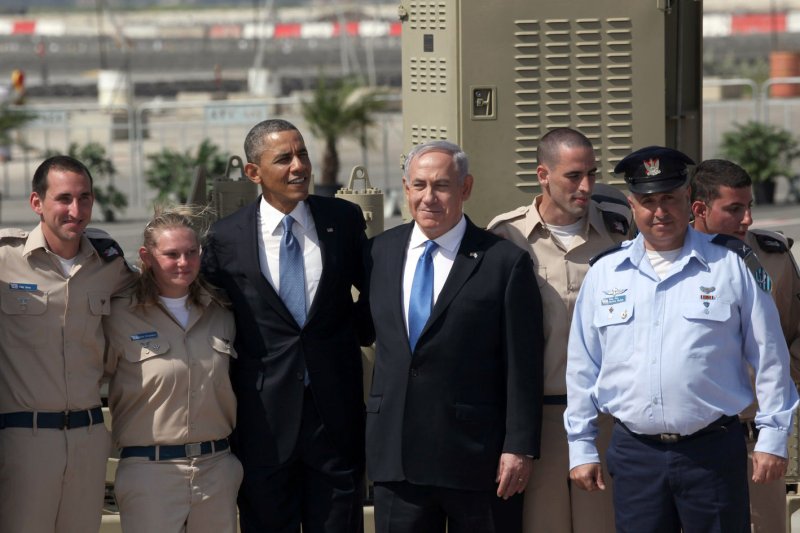U.S. President Barack Obama and Israeli Prime Minister Benjamin Netanyahu pose with Israeli military personnel at an Iron Dome Anti-Missle Battery, not seen, at Ben Gurion Airport near Tel Aviv, Israel, March 20, 2013. Obama will spend three days in the Holy Land on his first visit as President of the United States of America. UPI/Marc Israel Sellem-POOL |
License Photo
TEL AVIV, Israel, March 22 (UPI) -- Israel showcased its much-vaunted Iron Dome anti-missile system for U.S. President Barack Obama when he visited this week but in recent days the U.S.-funded system's declared shoot-down rate of 84 percent has been challenged by several scientists.
The conclusion was the kill rate was "more like 5 to 10 percent."
That could have a critical effect on long-term U.S. funding not only for Iron Dome, developed and produced by Israel's Rafael Advanced Defense Systems, but for other systems supported by U.S. aid that Israel's developing for a multilayered comprehensive missile defense shield.
The Israeli media reported that Obama, whose first function on arrival Wednesday was to inspect an Iron Dome battery at Ben Gurion Airport, had pledged to continue U.S. funding for the missile defense project, despite serious doubts raised about its stopping power.
Whether that's what will happen remains to be seen, given that the Americans are severely reducing defense spending, which could, despite pledges to the contrary, result in cutbacks in U.S. military aid to Israel.
It may have been coincidence that the day Obama arrived in the Jewish state Brig. Gen. Shachar Shohat, commander of the missile defense force, declared that the United States should be allowed to co-produce Iron Dome so it can benefit from the funds it has provided Israel to develop the system.
Shohat clearly had approval from Israeli Prime Minister Binyamin Netanyahu's government to make such a statement -- particularly since Israel roundly opposed a joint production deal when Washington proposed it in 2012.
But the recent publication of studies by three missile experts, conducted separately, and their conclusion that Iron Dome had failed miserably despite the Israeli military's claims, was widely perceived as an indictment of Israel's "wonder weapon."
The experts are Professor Theodore Postol, a world-renowned scientist with the Massachusetts Institute of Technology; Mordechai Shefer, an Israeli scientist formerly with Rafael, Iron Dome's Israeli developer; and a U.S. scientist identified only as "D" who recently worked at the U.S. Raytheon Co., which is co-developing another Israeli anti-missile system called David's Sling with Rafael.
Israeli security analyst Reuven Pedatzur, who's long been critical of Iron Dome, pulled these studies together in a hard-hitting article in the Haaretz daily that said the system was a dismal failure.
The three scientists maintained that studies of hundreds of videotaped Iron Dome interceptions during Israel's 8-day war with Palestinian militants in Gaza in November 2012 showed that most of the mid-air explosions recorded were actually the self-destruction of Iron Dome's Tamir interceptors and not the incoming rockets.
The Palestinians unleashed some 1,400 rockets in the fighting. Israel claimed Iron Dome intercepted 84.6 percent of the 400-plus rockets it engaged.
The system only attacks rockets whose trajectories indicate they'll hit populated areas, and ignores the others.
The military admitted that 58 rockets weren't intercepted.
Postol's done this before. After the 1990-91 Gulf War, during which the U.S. military lavishly praised the capabilities of Raytheon's Patriot missile system against Saddam Hussein's Scud ballistic missiles.
Postol investigated and concluded that these claims were erroneous; that Patriot could have hit less than 10 percent of its targets, and possibly none of them.
If the conclusions of Postol and his colleagues on Iron Dome are accurate, Israel has a problem. If it can't knock down unsophisticated, short-range rockets like the Palestinians' indigenous Qassem and Russian-designed Grad rockets, it's going to take a lot of punishment from the more advanced weapons held by Hezbollah in Lebanon.
Israel has five Iron Dome batteries, each costing $50 million, operational and says it needs another 13 to effectively protect the entire country. That would cost around $600 million.
Israel's Institute for National Security Studies denounced the findings of Pedatzur and the others, dismissing their "dubious research without access to credible data."
But even so, these reports are acutely embarrassing for Israeli as it presses Washington not reduce the $3 billion in military aid it provides annually, or the nearly $1 billion promised in funding for anti-missile systems.
Netanyahu and his generals can be expected to blast the conclusions of Postol and the others in the weeks ahead but if only some of these are accurate, Israel will have to rethink much of its current military strategy, particularly pre-emptive strikes to counter the Iranian threat.















